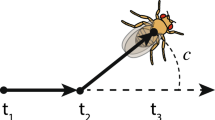Abstract
When two types ofDrosophila are in competition, the frequency dependence of mating success routinely is measured in our laboratory by direct observation of mating pairs in “Elens-Wattiaux” observation chambers. The present experiments concern white mutants (used here as a reference standard) in competition with three other genotypes: wild-type Canton S, “giant”gt w a, and “giant”gt 13z/w + Y/C(1)Dx, y f. From the present observations, the frequency dependence of mating success seems a very common phenomenon: a rare-type sexual advantage exists for females and for males. Sexual activity of male and femalewhite mutants is significantly higher when food is present in the mating chamber. Males of the other strains also are more active in the presence of food. Homogamic matings are more frequent amonggt 13z/w + Y/C(1)Dx, y f flies.
Similar content being viewed by others
References
Ayala, J. (1972). Frequency-dependent mating advantage inDrosophila.Behav. Genet. 2:85–91.
Ayala, J., and Campbell, C. A. (1974). Frequency dependent selection.Annu. Rev. Ecol. Syst. 5:115–138.
Brown, M. B., and Dixon, W. J. (1979).Biomedical Computer Program, University of California Press, London.
Bryant, E. H., Kence, A., and Kimball, K. T. (1980). A rare-male advantage in the housefly induced by wing-clipping, and some general consideration forDrosophila.Genetics 96:975–993.
Cereghetti, M., Jacquemin, F., Hols, P., Lichtenberger, M., and Elens, A. (1987). Measurement of frequency-dependent sexual activity inDrosophila melanogaster.Genetics 75:167–171.
Ehrman, L. (1965). Direct observation of sexual isolation between allopatric and between sympatric strains of differentDrosophila paulistorum races.Evolution 19:459–464.
Ehrman, L. (1966). Mating success and genotype frequency inDrosophila.Anim. Behav. 14:332–339.
Ehrman, L. (1988). Behavior Genetics Association Abstracts.Behav. Genet. 19:705.
Elens, A., and Wattiaux, J. M. (1964). Direct observation of sexual isolation.Dros. Info. Serv. 39:118–119.
Knoppien, P. (1985). Rere-male mating advantage: A review.Biol. Rev. 26:1155–1206.
Knoppien, P. (1987). Rare-male mating advantage: An artifact caused by differential storage conditions?Behav. Genet. 17:409–425.
kyriacou, C. P. (1987). Sexual feeding in fruitflies.Trends Evol. Ecol. 2:85–86.
Lechien, L., Libion-Mannaert M., and Elens, A. (1987). Food and frequency dependent sexual activity.Dros. Info. Serv. 66:91–93.
Leonard, J. E., and Ehrman, L. (1983). Does the rare male advantage results from faulty experimental design.Genetics 104:713–716.
Lichtenberger, M., Lechien, J., and Elems, A. (1987). Influence of light intensity on rate-male advantage inDrosophila melanogaster.Behav. Genet. 17:203–210.
Lichtenberger, M., Lechien, J., and Elens, A. (1988). The frequency dependence of mating success inDrosophila melanogaster.Genetica 77:25–52.
Lichtenberger, M., Lechien, J., and Elens, A. (1989). Influence of food on frequency-dependent sexual activity inDrosophila melanogaster.Behav. Genet. 19:575–592.
Markow, T. A. (1980). Rate-male advantage amongDrosophila of the same laboratory strain.Behav. Genet. 10:553–556.
Partridge, L. (1988). The rate-male effect: What is its evolutionary significance?Phil. Trans. R. Soc. Lond. B 319:525–539.
Petit, C. (1954). L'isolement sexuel chezDrosophila melanogaster. Etude du mutant white et de son allélomorphe sauvage.Bull. Biol. 88:435–443.
Petit, C., and Ehrman, L. (1968). Le role de la sélection sexuelle dans l'évolution des populations: l'avantage des types rares dans de groupeWillistoni (genreDrosophila, sous-geneSophophora).Bull. Biol. 102:433–446.
Snedecor, G. W., and Cochran, W. G. (1973).Statistical Methods, 6th ed., Iowa State Univertity Press, Ames.
Wattiaux, J. M. (1964). Mesure de l'isolement dexuel,Z. Verebungsl. 95:10–16.
Wattiaux, J. M. (1968). Cumulative parental age effects inDrosophila subobscura.Evolution 22:406–421.
Winer, B. J. (1971).Statistical Principles in Experimental Design, McGraw-Hill, New York.
Author information
Authors and Affiliations
Rights and permissions
About this article
Cite this article
Depiereux, E., Dernoncourt-Sterpin, C., Lechien, J. et al. Direct observation of sexual competition inDrosophila melanogaster: The mutantWhite in competition with other genotypes. Behav Genet 20, 511–533 (1990). https://doi.org/10.1007/BF01067717
Received:
Accepted:
Issue Date:
DOI: https://doi.org/10.1007/BF01067717




